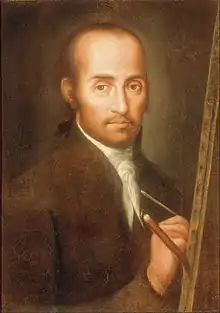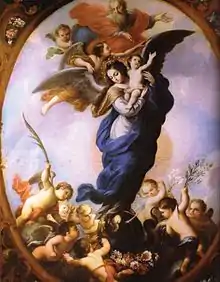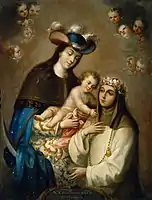José de Ibarra
José de Ibarra (1685–1756) was a Mexican painter, born in Guadalajara, Mexico, [1] and died 21 Nov 1756 in Mexico City, in the Viceroyalty of New Spain (Colonial México).[2]


He was born in 1753 in Mexico City, listed as a Spaniard in his birth certificate.[3] Ibarra was student of the distinguished painter Juan Correa, who was the son of a man of Afro-Moorish heritage from Spain and an Afro-Mexican woman.
Career
Ibarra's career was marked with support of initiatives to protect the intellectual integrity of painting as an art form.[4] He was influenced by contemporaries Cristóbal de Villalpando and Juan Rodríguez Juárez.[4] His remains are interred at the Church of Santa Inés in Mexico City.[5]
Many of Ibarra's pieces are preserved in Mexican museums and the Metropolitan Cathedral in Mexico City.[6] He was one of the most prolific painters of his day, producing mainly religious paintings for the cathedrals of Mexico.[4]
See also
References
- Toussaint, Manuel. Colonial Art in Mexico. Austin: University of Texas Press 1967, p. 333
- Ilona Katzew, "Valiant Styles: New Spanish Painting, 1700-85" in Painting in Latin America, 1550-1820, Luisa Elena Alcalá and Jonathan Brown, eds. New Haven: Yale University Press 2014, p. 169.
- Katzew, p. 169,citing Eduardo Báez Macías, "Planos y censos de la ciudad de México 1753", Boletín del Archivo General de la Nación, 2nd series, 8 nos 3-5 1976.
- "José de Ibarra". Retrieved 15 November 2008.
- Cuevas, Beatriz del Carmen. "Historia del Convento de Sta. Ines y creación del Museo JLC". Retrieved 28 March 2009.
- "Personaje". Archived from the original on 10 July 2011. Retrieved 15 November 2008.
Further reading
- Mues Orts, Paula. "El pintor novohispano José de Ibarra: imágenes retóricas y discursos pintados", PhD dissertation. Facultad de Filosofía y Letras, Universidad Nacional Autónoma de México." Mexico City 2009.
- Mues Orts, Paula. José de Ibarra, Profesor de la nobilísima arte de la pintura. Círculo de Arte. Mexico City 2001.
